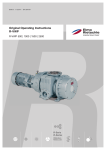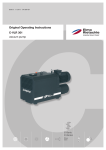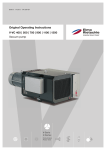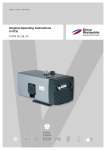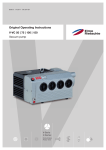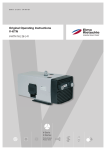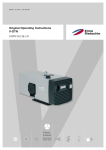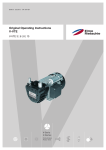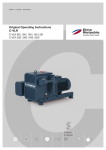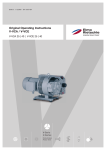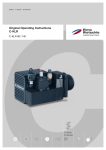Download Original Operating Instructions S-VSI
Transcript
Edition: 1.9.2011 · BA 832-EN Original Operating Instructions S-VSI S S-VSI 100 (01) | 300 (01) | 300 (12) S-Serie S-Series Schraube Screw Table of contents Table of contents 1 Foreword . . . . . . . . . . . . . . . . . . . . . . . . . . . . . . . . . . . . . . . . . . . . . . . . . . . . . . . . . . . . . . . . . . . 4 1.1 1.2 1.3 1.4 1.5 1.6 1.7 1.8 Principles . . . . . . . . . . . . . . . . . . . . . . . . . . . . . . . . . . . . . . . . . . . . . . . . . . . . . . . . . . . . . . . . . . . Target group . . . . . . . . . . . . . . . . . . . . . . . . . . . . . . . . . . . . . . . . . . . . . . . . . . . . . . . . . . . . . . . . . Supplier documentation and accompanying documents . . . . . . . . . . . . . . . . . . . . . . . . . . . . . . Abbreviations . . . . . . . . . . . . . . . . . . . . . . . . . . . . . . . . . . . . . . . . . . . . . . . . . . . . . . . . . . . . . . . . Directives, standards, laws . . . . . . . . . . . . . . . . . . . . . . . . . . . . . . . . . . . . . . . . . . . . . . . . . . . . . Symbols and meaning . . . . . . . . . . . . . . . . . . . . . . . . . . . . . . . . . . . . . . . . . . . . . . . . . . . . . . . . . Technical terms and meaning . . . . . . . . . . . . . . . . . . . . . . . . . . . . . . . . . . . . . . . . . . . . . . . . . . . Copyright . . . . . . . . . . . . . . . . . . . . . . . . . . . . . . . . . . . . . . . . . . . . . . . . . . . . . . . . . . . . . . . . . . . 4 4 4 4 4 5 5 5 2 Safety . . . . . . . . . . . . . . . . . . . . . . . . . . . . . . . . . . . . . . . . . . . . . . . . . . . . . . . . . . . . . . . . . . . . . 6 2.1 2.2 2.3 2.4 2.5 2.6 2.7 2.8 2.9 Warning instruction markings . . . . . . . . . . . . . . . . . . . . . . . . . . . . . . . . . . . . . . . . . . . . . . . . . . . General . . . . . . . . . . . . . . . . . . . . . . . . . . . . . . . . . . . . . . . . . . . . . . . . . . . . . . . . . . . . . . . . . . . . . Designated use . . . . . . . . . . . . . . . . . . . . . . . . . . . . . . . . . . . . . . . . . . . . . . . . . . . . . . . . . . . . . . Unacceptable operating modes. . . . . . . . . . . . . . . . . . . . . . . . . . . . . . . . . . . . . . . . . . . . . . . . . . Personal qualifications and training . . . . . . . . . . . . . . . . . . . . . . . . . . . . . . . . . . . . . . . . . . . . . . . Safety-conscious work . . . . . . . . . . . . . . . . . . . . . . . . . . . . . . . . . . . . . . . . . . . . . . . . . . . . . . . . Safety notes for the operator . . . . . . . . . . . . . . . . . . . . . . . . . . . . . . . . . . . . . . . . . . . . . . . . . . . . Safety instructions for installing, commissioning and maintenance . . . . . . . . . . . . . . . . . . . . . . Guarantee conditions . . . . . . . . . . . . . . . . . . . . . . . . . . . . . . . . . . . . . . . . . . . . . . . . . . . . . . . . . . 6 6 7 7 8 8 8 9 9 3 Transport, storage and disposal . . . . . . . . . . . . . . . . . . . . . . . . . . . . . . . . . . . . . . . . . . . . . . . . 10 3.1 3.3 Transportation . . . . . . . . . . . . . . . . . . . . . . . . . . . . . . . . . . . . . . . . . . . . . . . . . . . . . . . . . . . . . . . 3.1.1 Unpack and check the delivery condition . . . . . . . . . . . . . . . . . . . . . . . . . . . . . . . . . . 3.1.2 Lifting and transporting. . . . . . . . . . . . . . . . . . . . . . . . . . . . . . . . . . . . . . . . . . . . . . . . . Storage. . . . . . . . . . . . . . . . . . . . . . . . . . . . . . . . . . . . . . . . . . . . . . . . . . . . . . . . . . . . . . . . . . . . . 3.2.1 Ambient conditions for storage . . . . . . . . . . . . . . . . . . . . . . . . . . . . . . . . . . . . . . . . . . Disposal . . . . . . . . . . . . . . . . . . . . . . . . . . . . . . . . . . . . . . . . . . . . . . . . . . . . . . . . . . . . . . . . . . . . 10 10 10 11 11 11 4 Set up and operation . . . . . . . . . . . . . . . . . . . . . . . . . . . . . . . . . . . . . . . . . . . . . . . . . . . . . . . . . 12 4.1 4.2 4.3 4.4 Setup . . . . . . . . . . . . . . . . . . . . . . . . . . . . . . . . . . . . . . . . . . . . . . . . . . . . . . . . . . . . . . . . . . . . . . 4.1.1 Data plate . . . . . . . . . . . . . . . . . . . . . . . . . . . . . . . . . . . . . . . . . . . . . . . . . . . . . . . . . . . Description . . . . . . . . . . . . . . . . . . . . . . . . . . . . . . . . . . . . . . . . . . . . . . . . . . . . . . . . . . . . . . . . . . Areas of application . . . . . . . . . . . . . . . . . . . . . . . . . . . . . . . . . . . . . . . . . . . . . . . . . . . . . . . . . . . Cooling the machine . . . . . . . . . . . . . . . . . . . . . . . . . . . . . . . . . . . . . . . . . . . . . . . . . . . . . . . . . . 4.4.1 Continuous flow cooling (Standard version) . . . . . . . . . . . . . . . . . . . . . . . . . . . . . . . . 4.4.2 Circulation cooling (option) . . . . . . . . . . . . . . . . . . . . . . . . . . . . . . . . . . . . . . . . . . . . . . 12 14 14 15 16 16 17 5 Installation . . . . . . . . . . . . . . . . . . . . . . . . . . . . . . . . . . . . . . . . . . . . . . . . . . . . . . . . . . . . . . . . . 18 5.1 5.2 5.3 5.4 5.5 5.6 Preparing for installation . . . . . . . . . . . . . . . . . . . . . . . . . . . . . . . . . . . . . . . . . . . . . . . . . . . . . . . Installation . . . . . . . . . . . . . . . . . . . . . . . . . . . . . . . . . . . . . . . . . . . . . . . . . . . . . . . . . . . . . . . . . . Connecting pipes . . . . . . . . . . . . . . . . . . . . . . . . . . . . . . . . . . . . . . . . . . . . . . . . . . . . . . . . . . . . . Connecting the cooling water pipe . . . . . . . . . . . . . . . . . . . . . . . . . . . . . . . . . . . . . . . . . . . . . . . Filling with lubricating oil . . . . . . . . . . . . . . . . . . . . . . . . . . . . . . . . . . . . . . . . . . . . . . . . . . . . . . . Connecting the motor . . . . . . . . . . . . . . . . . . . . . . . . . . . . . . . . . . . . . . . . . . . . . . . . . . . . . . . . . 18 18 19 20 22 22 3.2 2 | www.gd-elmorietschle.com © Gardner Denver Schopfheim GmbH, Gardner Denver Deutschland GmbH Table of contents 6 Commissioning and decommissioning . . . . . . . . . . . . . . . . . . . . . . . . . . . . . . . . . . . . . . . . . . 23 6.1 6.2 6.3 Commissioning . . . . . . . . . . . . . . . . . . . . . . . . . . . . . . . . . . . . . . . . . . . . . . . . . . . . . . . . . . . . . . 6.1.1 Checking the rotation direction. . . . . . . . . . . . . . . . . . . . . . . . . . . . . . . . . . . . . . . . . . . Decommissioning/ storing . . . . . . . . . . . . . . . . . . . . . . . . . . . . . . . . . . . . . . . . . . . . . . . . . . . . . . Re-commissioning . . . . . . . . . . . . . . . . . . . . . . . . . . . . . . . . . . . . . . . . . . . . . . . . . . . . . . . . . . . . 23 24 24 24 7 Maintenance and repair . . . . . . . . . . . . . . . . . . . . . . . . . . . . . . . . . . . . . . . . . . . . . . . . . . . . . . . 25 7.1 7.2 7.3 7.4 Ensuring operational safety . . . . . . . . . . . . . . . . . . . . . . . . . . . . . . . . . . . . . . . . . . . . . . . . . . . . . Maintenance work . . . . . . . . . . . . . . . . . . . . . . . . . . . . . . . . . . . . . . . . . . . . . . . . . . . . . . . . . . . . 7.2.1 Changing the oil . . . . . . . . . . . . . . . . . . . . . . . . . . . . . . . . . . . . . . . . . . . . . . . . . . . . . . 7.2.1 Ölwechsel . . . . . . . . . . . . . . . . . . . . . . . . . . . . . . . . . . . . . . . . . . . . . . . . . . . . . . . . . . . 7.2.2 Air filtering . . . . . . . . . . . . . . . . . . . . . . . . . . . . . . . . . . . . . . . . . . . . . . . . . . . . . . . . . . . 7.2.3 Coupling . . . . . . . . . . . . . . . . . . . . . . . . . . . . . . . . . . . . . . . . . . . . . . . . . . . . . . . . . . . . 7.2.4 Cooling . . . . . . . . . . . . . . . . . . . . . . . . . . . . . . . . . . . . . . . . . . . . . . . . . . . . . . . . . . . . . Repair/ Service . . . . . . . . . . . . . . . . . . . . . . . . . . . . . . . . . . . . . . . . . . . . . . . . . . . . . . . . . . . . . . . Spare parts. . . . . . . . . . . . . . . . . . . . . . . . . . . . . . . . . . . . . . . . . . . . . . . . . . . . . . . . . . . . . . . . . . 25 26 27 27 28 30 30 31 32 8 Malfunctions: Causes and elimination . . . . . . . . . . . . . . . . . . . . . . . . . . . . . . . . . . . . . . . . . . . 33 9 Technical Data . . . . . . . . . . . . . . . . . . . . . . . . . . . . . . . . . . . . . . . . . . . . . . . . . . . . . . . . . . . . . . 35 | 3 www.gd-elmorietschle.com © Gardner Denver Schopfheim GmbH, Gardner Denver Deutschland GmbH Foreword 1 Foreword 1.1 Principles These operating instructions: 1.2 • are a part of the following screw vacuum pumps S-VSI 100 (01), S-VSI 300 (01) and S-VSI 300 (12). • describe how to use them safely and properly in all life phases. • must be available where the equipment is used. Target group The target group for these instructions is technically trained specialists. 1.3 Supplier documentation and accompanying documents Document Contents No. Operating Instructions BA 832-EN Declaration of Conformity C 0084-EN Declaration of harmlessness 7.7025.003.17 Spare parts' list Spare parts document E 832 Data sheet Technical data and graphs D 832 / D 832/12 Info sheet Storage guidelines for machines I 150-EN Info sheet Recommended water quality I 832-EN Manufacturer’s declaration EU Directive 2002/95/EG (RoHS) — Supplier documentation 1.4 Abbreviations 1.5 Fig. Figure S-VSI Vacuum pump m3/h Pumping capacity mbar (abs.) Final vacuum, operating vacuum Directives, standards, laws See Conformity Declaration 4 | www.gd-elmorietschle.com © Gardner Denver Schopfheim GmbH, Gardner Denver Deutschland GmbH Foreword 1.6 Symbols and meaning Symbol Explanation Condition, pre-requisite #### a), b),... Instructions, action Instructions in several steps Results [-> 14] Cross reference with page number Information, note Safety symbol Warns of potential risk of injury Obey all the safety instructions with this symbol in order to avoid injury and death. 1.7 Technical terms and meaning Term Explanation Machine Pump and motor combination ready to be connected Motor Pump drive motor Vacuum pump Machine to create a vacuum Screw Machine‘s design or active principle Pumping capacity Vacuum pump volume flow related to the condition in the suction connection Final pressure (abs.) The maximum vacuum that a pump reaches when the suction opening is closed. Given as absolute pressure. Permanent vacuum The vacuum or the suction range at which the pump operates permanently. The permanent vacuum or intake pressure is ≥ than the final vacuum and < than the atmospheric pressure. Noise emission 1.8 The noise emitted at a specific loading given as a figure, sound pressure level dB(A) as per EN ISO 3744. Copyright Passing on or copying this document, using and providing information on its contents are prohibited unless expressly permitted. Contraventions will lead to claims for damages. www.gd-elmorietschle.com © Gardner Denver Schopfheim GmbH, Gardner Denver Deutschland GmbH | 5 Safety 2 Safety The manufacturer is not responsible for damage if you do not follow all of this documentation. 2.1 Warning instruction markings Warning Danger level Consequences if not obeyed DANGER immediately imminent danger Death, severe bodily injury WARNING possible imminent danger Death, severe bodily injury CAUTION possible hazardous situation Slight bodily injury possible hazardous situation Material damage NOTICE 2.2 General These operating instructions contain basic instructions for installation, commissioning, maintenance and inspection work which must be obeyed to ensure the safe operation of the machine and prevent physical and material damage. The safety instructions in all sections must be taken into consideration.The operating instructions must be read by the responsible technical personnel/ operator before installing and commissioning / and must be fully understood. The contents of the operating instructions must always be available on site for the technical personnel / operator. Instructions fixed directly onto the machine must be obeyed and must always remain legible. This applies for example to: • Symbols for connections • Data and motor data plate • Instruction and warning plates The operator is responsible for observing local regulations. 6 | www.gd-elmorietschle.com © Gardner Denver Schopfheim GmbH, Gardner Denver Deutschland GmbH Safety 2.3 Designated use The machine must only be operated in such areas as are described in the operating instructions: • only operate the machine in a technically perfect condition • do not operate the machine when it is only partially assembled the machine must only be operated at an ambient temperature and suction temperature of between 5 and 40°C. Please contact us for temperatures outside this range. the machine may convey, compress or extract the following media: • all non-explosive, non-inflammable, non-aggressive and non-poisonous dry gases and gas air mixtures • also to feed in extremely damp gases. The water vapour compatibility is very high. • • 2.4 Unacceptable operating modes • extracting, conveying and compressing explosive, inflammable, aggressive or poisonous media, e.g. dust as per ATEX zone 20-22, solvents as well as gaseous oxygen and other oxidants, water vapour, liquids or solid materials • using the machine in non-commercial plants if the necessary precautions and protective measures have not been taken in the plant • installing in environments that are at risk of explosions • using the machine in areas with ionising radiation • back pressures on the outlet side: S-VSI (01) - (07) > + 0,2 bar S-VSI (12) > + 30 mbar • Modifications to the machine and accessories www.gd-elmorietschle.com © Gardner Denver Schopfheim GmbH, Gardner Denver Deutschland GmbH | 7 Safety 2.5 Personal qualifications and training • Ensure that people entrusted with working on the machine have read and understood these operating instructions before starting work, particularly the safety instructions for installation, commissioning, maintenance and inspection work. • Manage the responsibilities, competence and monitoring of staff • all work must only be carried out be technical specialists: • Installation, commissioning, maintenance and inspection work • Working with electricity • 2.6 personnel being trained to work on the machine must be supervised by technical specialists only Safety-conscious work The following safety regulations apply in addition to the safety instructions and intended use listed in these instructions: 2.7 8 • Accident prevention regulations, safety and operating regulations • the standards and laws in force • hot parts of the machine must not be accessible during operation or must be fitted with a guard • People must not be endangered by the free extraction or discharge of pumped media • Risks arising from electrical energy must be eliminated Safety notes for the operator | www.gd-elmorietschle.com © Gardner Denver Schopfheim GmbH, Gardner Denver Deutschland GmbH Safety 2.8 2.9 Safety instructions for installing, commissioning and maintenance • The operator will ensure that any installation, commissioning and maintenance work is carried out by authorised, qualified specialists who have gained sufficient information by an in-depth study of the operating instructions. • Only work on the machine when it is idle and cannot be switched on again • Ensure that you follow the procedure for decommissioning the machine described in the operating instructions. • Fit or start up safety and protective devices again immediately after finishing work. • Conversion work or modifications to the machine are only permissible with the manufacturer’s consent. • Only use original parts or parts approved by the manufacturer. The use of other parts may invalidate liability for any consequences arising. • Keep unauthorised people away from the machine Guarantee conditions The manufacturer’s guarantee or warranty will no longer apply in the following cases: • Improper use • Not complying with these instructions • Operation by insufficiently qualified staff • Using spare parts that have not been approved by Gardner Denver Schopfheim GmbH • Unauthorised modifications to the machine or the accessories supplied by Gardner Denver Schopfheim GmbH www.gd-elmorietschle.com © Gardner Denver Schopfheim GmbH, Gardner Denver Deutschland GmbH | 9 Transport, storage and disposal 3 Transport, storage and disposal 3.1 Transportation 3.1.1 Unpack and check the delivery condition a) Unpack the machine on receipt and check for transport damage. b) Notify the manufacturer of transport damage immediately. c) Dispose of the packaging in accordance with the local regulations in force. 3.1.2 Lifting and transporting WARNING Death or limbs crushed as a result of the items being transported falling or tipping over. a) b) c) d) When transporting with the lifting device remember: Select the lifting device suitable for the total weight to be transported. Ensure that the machine cannot tip and fall. Do not stop under a suspended load. Put the goods to be conveyed on a horizontal base. Lifting device/ Transporting with a crane WARNING Bodily injury resulting from improper operation a) Loads crosswise to the ring level are not permitted. b) Avoid impact stress. 1 1 Fig. 1 Lifting and transporting 1 10 a) Tighten the eyebolts (Fig. 1/1) firmly. b) The machine must be suspended on the eyebolt using the lifting device for lifting and transporting. Eyebolt | www.gd-elmorietschle.com © Gardner Denver Schopfheim GmbH, Gardner Denver Deutschland GmbH Transport, storage and disposal 3.2 Storage NOTICE Material damage caused by improper storage. Ensure that the storage area meets the following conditions: a) dust free b) vibration free 3.2.1 Ambient conditions for storage Ambient conditions Value Relative humidity 0% to 80% Lagertemperatur -10°C to +60°C The machine must be stored in a dry environment with normal air humidity. It should not be stored for more than 6 months. see Info “Machine storage guidelines”, Page 4 3.3 Disposal WARNING Danger from inflammable, corrosive or poisonous substances! Machines that come into contact with hazardous substances must be decontaminated before disposal. a) b) c) d) e) When disposing ensure the following: Collect oils and grease separately and dispose of in accordance with the local regulations in force. Do not mix solvents, limescale removers and paint residues. Remove components and dispose of them in accordance with the local regulations in force. Dispose of the machine in accordance with the national and local regulations in force. Parts subject to wear and tear (marked as such in the spare parts list) are special waste and must be disposed of in accordance with the national and local waste laws. www.gd-elmorietschle.com © Gardner Denver Schopfheim GmbH, Gardner Denver Deutschland GmbH | 11 Set up and operation 4 Set up and operation 4.1 Setup P1 O H M S-VSI (01) U1 F A H1 M E F K D1 I D C K1 N A B Z Fig. 2 Q Vacuum pump S-VSI 100 A Vacuum connection K, K1 Oil discharge point B Exhaust air outlet M Oil recommendation plate C Cooling water inlet G 3/8 N Data plate 3 D Cooling water outlet G /8 O Rotation direction plate D1 Cooling water drain P Drive motor E Cooling air inlet P1 Motor data plate F Cooling air outlet Q hot surfaces > 70°C H, H 1 Oil filling point U1 Vent valve I, I 1 Z Outlet silencer 12 Oil sight glass | www.gd-elmorietschle.com © Gardner Denver Schopfheim GmbH, Gardner Denver Deutschland GmbH I1 P Set up and operation S-VSI (12) P P1 O N H M U1 F H1 A E D M I1 F C K1 B Q I K D1 U Q Z Fig. 3 Vacuum pump S-VSI 300 (12) A Vacuum connection M Oil recommendation plate B Exhaust air outlet N Data plate C Cooling water inlet O Rotation direction plate D Cooling water outlet P Drive motor D1 Cooling water drain P1 Motor data plate E Cooling air inlet Q hot surfaces > 70°C F Cooling air outlet U Gas ballast valve H, H 1 Oil filling point U1 Vent valve I, I 1 Z Outlet silencer Oil sight glass K, K1 Oil discharge point www.gd-elmorietschle.com © Gardner Denver Schopfheim GmbH, Gardner Denver Deutschland GmbH | 13 Set up and operation 4.1.1 Data plate 1 2 3 4 5 616& 7<396, (1 6 N: ,' PEDUDEV PñK PLQ 0DGHLQ*HUPDQ\5RJJHQEDFKVWUDVVH'6FKRSIKHLP 8 9 Fig. 4 7 1 Type/ Size (mechanical version) 2 Serial number 3 Year of construction 4 Item no. 5 Final pressure (abs.) 6 Pumping capacity 7 Speed 8 Motor output 9 Operating mode 6 Data plate 4.2 Description The S-VSI model range has a connecting thread on the suction side and an exhaust silencer on the pressure side. The TWISTER S-VSI is a double shaft screw vacuum pump in which two parallel screw rotors roll off against each other without touching and dry. The gas to be fed in is here enclosed in the pump’s suction chamber and compressed by the rotary movement of the screw rotors in the direction of the outlet. The gas sucked in is gradually compressed to atmospheric pressure. The counter-rotating screw rotors are synchronised by a gear pair in the gearbox. The synchronous gearbox gear wheels and the bearings are lubricated with oil. These components are in a gearbox that also contains the oil supply. Oil conveying devices always ensure that the bearings and the gear wheels are sufficiently supplied with oil at all permissible speeds. The gearbox and the compression chamber are separated from each other by special seals. The gearbox is sealed from the outside with shaft seals and O rings, the compressor chamber with piston rings. Between the two there is also another atmospherically ventilated area that can be loaded with sealing gas (special version). The TWISTER S-VSI is driven by standard flanged three phase motors via a coupling (with an elastomer component). 14 | www.gd-elmorietschle.com © Gardner Denver Schopfheim GmbH, Gardner Denver Deutschland GmbH Set up and operation 4.3 Areas of application The screw vacuum pumps are suitable for the evacuation of closed systems or for a continuous vacuum within the following intake pressure ranges: 0.1 to 1000 mbar (abs.). They are also particularly suitable for feeding in extremely damp gases. The water vapour compatibility is very high. The maximum pumping capacity with free suction is 110 m3/h and 320 m3/h at 50 Hz. Data sheet D 832 shows the dependency of the pumping capacity on the intake pressure. If the unit is switched on more frequently (at regular intervals of about 10 times an hour) or at higher ambient temperatures and intake temperatures, the excess temperature limit of the motor winding and the bearings may be exceeded.Please contact the manufacturer should the unit be used under such conditions. If it is installed in the open air the unit must be protected from environmental influences, (e.g. by a protective roof). ACHTUNG The srew vacuum pump S-VSI 300 (12) may only be operated in continuous operation S1. When evacuating closed systems the volume to be evacuated must be max. 80 l. www.gd-elmorietschle.com © Gardner Denver Schopfheim GmbH, Gardner Denver Deutschland GmbH | 15 Set up and operation 4.4 Cooling the machine 4.4.1 Continuous flow cooling (Standard version) With continuous flow cooling water flows continuously through the cavity in the double walled compressor housing. For safety reasons the cooling system should be fitted with a solenoid valve, temperature and a flow switch. The assembly group continuous flow water cooling (Fig. 5) as well as a special control unit are obtainable. U5 U4 U3 U1 D C U6 U2 Fig. 5 Assembly group continuous flow water cooling (option) C Cooling water inlet G 1/2 D Cooling water outlet G 1/2 U1 Vent valve U2 Temperature control U3 Safety valve U4 Flow control device U5 Solenoid valve U6 Dirt trap Temperature control Monitors the temperature of the cooling water. Factory-provided adjustment: Tmax = 50 °C Safety valve Protect from an incorrect operating pressure of the cooling water > 6 bar. Flow control device Monitors the flow rate of the cooling water. Factory-provided adjustment: 400 l / h Solenoid valve Regulate the cooling circuit. Control voltage: 24 V DC Dirt trap Protect the armatures and the cooling circuit from impurities in the incoming cooling liquid. 16 | www.gd-elmorietschle.com © Gardner Denver Schopfheim GmbH, Gardner Denver Deutschland GmbH Set up and operation Control unit (option) Analyse the signals of the monitoring devices and control motor as well as solenoid valve. Fig. 6 Control unit (option) 4.4.2 Circulation cooling (option) F Y 580 mm F C2 E D2 65 0m m Fig. 7 Circulation cooling system (option) C2 Cooling water inlet G 3/4 D2 Cooling water outlet G 3/4 E Cooling air inlet F Cooling air outlet Y Display 580 mm The cooling circuit is fitted with thermostat-controlled three-way valves. This enables diversion of water past the heat exchanger during the pump start-up phase. During operation of the pump, a temperature switch monitors the water temperature and a flow switch controls the flow rate. The cooling system is equipped with a temperature and flow switch. Weight / operating weight Tank capacity 101 / 131 kg 30 l Further detailed technical data on request The Operating Instructions for this cooling system is enclosed on the device. www.gd-elmorietschle.com © Gardner Denver Schopfheim GmbH, Gardner Denver Deutschland GmbH | 17 Installation 5 Installation 5.1 Preparing for installation Check the following points: • • • • • Machine freely accessible from all sides Do not close ventilation grids and holes Sufficient room for installing and removing pipes and for maintenance work, particularly for installing and dismantling the machine No external vibration effects Do not suck any hot exhaust air from other machines into the cooling system. The oil filling point (Fig. 2/H, H1), oil sight glass (Fig. 2/I, I1) and oil outlets (Fig. 2/K, K1), cooling water inlet (Fig. 2/C) and cooling water outlet (Fig. 2/D) must be easily accessible. The cooling air inlets (Fig. 2/E) and cooling air outlets (Fig. 2/F) must be at least 30 cm away from adjacent walls. Cooling air coming out must not be sucked in again. 5.2 Installation NOTICE The machine may only be operated when it is set up horizontally. Material damage resulting from the machine tipping over and falling. When installed at more than 1000 m above sea level a reduction in power is noticeable. In this case we would ask you to contact us. Contamination in the intake air To protect the machine the operator should install appropriate filters on the suction side. Check for oil leakage Risk of falling in oil spills! Ensure that the foundation complies with the following conditions: • Level and straight • The bearing surface must be designed to be able to take the weight of the machine. It is possible to install the machine on a firm base without anchoring. When installing on a substructure we recommend fixing with flexible buffers. 18 | www.gd-elmorietschle.com © Gardner Denver Schopfheim GmbH, Gardner Denver Deutschland GmbH Installation 5.3 Connecting pipes a) Vacuum connection at (Fig. 2/A, 3/A). NOTICE Material damage resulting from the forces and torques of the pipes on the unit being too high. Only screw pipes in by hand. The pumping capacity of the vacuum pump is reduced if the suction pipe is too narrow and/or too long. b) The discharged air can be blown out through the exhaust silencer (ZSZ) at (Fig. 2/B, 3/B) or conducted away using a hose or a pipe. NOTICE Length of the connection pipes With connection pipes that have the same pipe cross section as the machine connection and are more than 3 m long, a non-return valve (ZRK) especially for the purpose must be installed in order to avoid reverse operation when the machine has stopped. The air vent (Fig. 2/B) must not be closed or restricted. Counter pressures on the outlet side are only permissible up to: S-VSI (01) - (07) < + 0,2 bar S-VSI (12) < + 30 mbar Prevent liquids accumulating in the exhaust line. www.gd-elmorietschle.com © Gardner Denver Schopfheim GmbH, Gardner Denver Deutschland GmbH | 19 Installation 5.4 Connecting the cooling water pipe NOTICE Cooling water control! The vacuum pump must not be operated without cooling water control. Danger breakdown of the pump Ensure that the cooling water stream is not interrupted. a) Connect the cooling water pipe to the cooling water inlet (Fig. 2/C, 3/C) and the cooling water discharge pipe to the cooling water outlet (Fig. 2/D, 3/D). NOTICE Only use pH-neutral, clean and filtered water for cooling Dirt particles and aggressive water may lead to malfunctions or to premature wear in the cooling system Suitable cooling water see Info “Recommended water quality”, Page 4 NOTICE The cooling water operating pressure must not exceed 6 bar Cooling water temperature must be between 15 - 50 °C. 20 | www.gd-elmorietschle.com © Gardner Denver Schopfheim GmbH, Gardner Denver Deutschland GmbH Installation b) When connecting a circulating cooling system to an external cooling system, it must be filled with cooling fluid. NOTICE Rinse the pipe network on the customer side before connecting it A filter element must be installed in the pipe network to prevent foreign bodies getting into the heat exchanger. Risk of frost damage in the cooling system Freezing cooling water may lead to extensive damage to the machine. Therefore mix the cooling water with at least 10 % of anti-freeze. The amount of anti-freeze used must be adjusted to the ambient climatic conditions. Handling anti-freeze Anti-freeze may contain harmful ingredients, such as ethylene glycol that could damage your health, especially if swallowed. www.gd-elmorietschle.com © Gardner Denver Schopfheim GmbH, Gardner Denver Deutschland GmbH | 21 Installation 5.5 Filling with lubricating oil a) Fill the lubricating oil (for suitable sorts see „Maintenance“) for the gear teeth and the bearings into the oil filling points (Fig. 2/H, 2/H1) up to the middle of the inspection glasses (Fig. 2/ I, 2/I1). b) Close the oil filling points. 5.6 Connecting the motor DANGER Danger of death if the electrical installation has not been done professionally! The electrical installation may only be done by a specialist electrician observing EN 60204. The operating company has to provide the main switch. a) The motor‘s electrical data is given on the data plate (Fig. 2/N) or on the motor data plate (Fig. 2/ P1). The motors comply with DIN EN 60034 and are in protection class IP 55 and insulation class F. The appropriate connection diagram is located in the motor‘s terminal box (not for the plug connection version). The motor data must be compared with the data of the existing mains network (current type, voltage, network frequency, permitted current value). b) Connect the motor via the plug connection or the motor protection switch (for safety reasons, a motor protection switch is required and the connecting cable must be installed via a cable fitting to provide strain relief). We recommend using motor protection switches with delayed switch off, depending on possible excess current. Temporary excess current may occur when the machine is started cold. NOTICE Power supply The conditions at the installation location must match the information on the motor data plate. Without derating the following is permissible: • ± 5% Voltage deviation • ± 2% Frequency deviation 22 | www.gd-elmorietschle.com © Gardner Denver Schopfheim GmbH, Gardner Denver Deutschland GmbH Commissioning and decommissioning 6 Commissioning and decommissioning 6.1 Commissioning WARNING Improper use May lead to severe or fatal injuries. Therefore be sure to obey the safety instructions. CAUTION Hot surfaces When the machine is at operating temperature the surface temperatures on the components (Fig. 2/ Q) may go above 70°C. You must avoid touching the hot surfaces (marked with warning plates)! CAUTION Noise emission The highest noise pressure levels measured as per EN ISO 3744 are given in Section 9. When spending a long time in the vicinity of the running machine use ear protectors to avoid permanent damage to your hearing. CAUTION Do not put your hands onto the suction connection to check the suction NOTICE Do not operate without water cooling with a sufficient amount of cooling water The power of the machine lessens and damage may occur to the machine. www.gd-elmorietschle.com © Gardner Denver Schopfheim GmbH, Gardner Denver Deutschland GmbH | 23 Commissioning and decommissioning 6.1.1 Checking the rotation direction The drive shaft direction of rotation is shown by the rotation direction arrow (Fig. 2/O) on the motor flange. a) Start the motor briefly (max. two seconds) to check the direction of rotation. When looking at the motor fan, it must rotate clockwise. NOTICE Incorrect direction of rotation Operating in the wrong direction of rotation leads to damage to the machine. Use a phase sequence indicator to check the direction of rotation (anti-clockwise rotating field). 6.2 Decommissioning/ storing Stop the machine a) Switch the machine off. b) If available close the cut off device in the suction and pressure pipe. c) Disconnect the machine from the electricity source. d) Depressurise the machine: Open the pipes slowly The pressure reduces slowly. e) Remove the pipes and hoses. f) Seal the connections for suction and discharge nozzles with adhesive foil. g) Discharge cooling water (Fig. 2/D1, 3/D1). see also Section 3.2.1, Page 11 6.3 Re-commissioning a) Check the condition of the machine (cleanliness, cabling etc.). For installation see Section 5 Page 18 For commissioning see Section 6.1 Page 23 24 | www.gd-elmorietschle.com © Gardner Denver Schopfheim GmbH, Gardner Denver Deutschland GmbH Maintenance and repair 7 Maintenance and repair DANGER Danger of death from touching live parts! Before maintenance work disconnect the machine by pressing the main switch or unplugging it and ensure that it cannot be turned on again. WARNING Hot surfaces and equipment During maintenance work there is the danger of getting burnt on hot components (Fig. 2/Q) and by the machine lubricating oil. Wait for the machine to cool down. 7.1 Ensuring operational safety Regular maintenance work must be carried out in order to ensure operational safety. Maintenance intervals also depend on the operational demands on the machine. With any work observe the safety instructions described in Section 2.8 “Safety notes for installation, commissioning and maintenance”. The whole unit should always be kept in a clean condition. www.gd-elmorietschle.com © Gardner Denver Schopfheim GmbH, Gardner Denver Deutschland GmbH | 25 Maintenance and repair 7.2 Maintenance work Interval Maintenance to be carried out Section monthly Check the pipes and screws for leaks and to ensure they are seated properly and if necessary seal again or tighten up. — monthly Check the cooling water system and the pipes. — monthly Check the terminal box and cable inlet holes for leaks and if necessary re-seal. — monatlich Kühlrippen der Maschine und des Motor reinigen. — monthly Check the oil level 7.2.1 7,500 h Changing the oil depending on how dirty the discharged medium is Clean intake air filter Clean gas ballast valve filter 7.2.2 at least once a year Check for coupling wear 7.2.3 monthly Check the cooling water system and the pipes. 7.2.4 depending on how dirty the cooling liquid is Clean dirt trap 26 | www.gd-elmorietschle.com © Gardner Denver Schopfheim GmbH, Gardner Denver Deutschland GmbH Maintenance and repair 7.2.1 Changing the oil 7.2.1 Ölwechsel H M H1 K Fig. 8 Changing the oil H, H 1 Oil filling point I, I 1 Oil sight glass K, K1 Oil discharge point M Oil recommendation plate I M K1 I1 NOTICE Always change the oil when the machine is at operating temperature and in an atmospherically ventilated area. If it is not completely emptied the amount that can be refilled is reduced. The waste oil must be disposed of in compliance with the local environmental protection regulations. If you change the type of oil, empty the oil tank completely. The oil level in the sight glasses (Fig. 8/I, I1) must be checked every month. When refilling with oil the machine must be switched off and vented to atmospheric pressure. With clean operations the oil must be changed after every 7,500 operating hours. The oil viscosity must comply with ISO VG 150 as per DIN 51519. Designation as per DIN 51502: CLP HC 150. GEAR-LUBE 150 or equivalent oils by other manufacturers (also see oil recommendation plate (Fig. 8/ M)). www.gd-elmorietschle.com © Gardner Denver Schopfheim GmbH, Gardner Denver Deutschland GmbH | 27 Maintenance and repair 7.2.2 Air filtering S-VSI (12) A f U Fig. 9 Air filtering A Vacuum connection U Gas ballast valve (S-VSI (12)) f Mesh filter NOTICE Insufficient maintenance on the air filter The power of the machine lessens and damage may occur to the machine. The mesh filter (Fig. 9/f) built into the vacuum connection (Fig. 9/A) must be cleaned by washing respectively blowing it out (depending on the level of contamination of the suctioned medium) or replaced. 28 | www.gd-elmorietschle.com © Gardner Denver Schopfheim GmbH, Gardner Denver Deutschland GmbH Maintenance and repair h1 f3 f4 Gas ballast valve filter: The pumps S-VSI (12) work with a gas ballast valve (Fig. 9/U). The inbuilt filter disc Fig. 10/f3) and micro filter discs Fig. 10/f4) must be cleaned more or less often by purging depending on how dirty the medium flowing through is. By undoing the countersunk screw (Fig. 10/g1) and removing the plastic cover (Fig. 10/ h1) the filter parts can be removed for cleaning. Re-assemble in reverse order. g1 f4 Fig. 10 Gas ballast valve h1 Cover f3 Filter disc g1 Countersunk screw f4 Micro filter discs WARNING Danger of injury when dealing with compressed air When blowing through with compressed air, solid particles may be carried along or powder dust swirling around may cause injury to the eyes. Therefore, when cleaning with compressed air always wear goggles and a dust mask. 1 2 Fig. 11 Blowing out the mesh filter 1 Mesh filter 2 Compressed air www.gd-elmorietschle.com © Gardner Denver Schopfheim GmbH, Gardner Denver Deutschland GmbH | 29 Maintenance and repair 7.2.3 Coupling The coupling sprocket (Fig. 12/k) is subject to wear and must be checked regularly (at least once a year). s5 CAUTION k n m q Fig. 12 Coupling k Coupling sprocket m Motor n Motor flange housing q Coupling half on the motor side s5 Screws Defective coupling sprocket Defective sprockets may lead to the rotor shaft breaking. To check the coupling switch the motor (Fig. 12/m) off and ensure that it cannot be switched on again. Undo the screws (Fig. 12/s5) on the motor flange. Remove motor and the coupling half on the motor side (Fig. 12/q) from the motor flange housing (Fig. 12/n) axially and suspend with a lifting device. If the sprocket (Fig. 12/k) is damaged or worn, then replace it. NOTICE Frequent starting up and high ambient temperature The service life of the sprocket (Fig. 12/k) is reduced as a result of this. Re-assemble in reverse order. 7.2.4 Cooling Check the cooling water system and the pipes monthly. Continuous flow cooling The dirt trap (Fig. 5/U6) must be cleaned periodically, depending on the cooling liquid quality. To do this unscrew the lock screw and clean the built-in mesh filter. Circulation cooling For maintainance see Operating Instructions, is enclosed on the cooling device 30 | www.gd-elmorietschle.com © Gardner Denver Schopfheim GmbH, Gardner Denver Deutschland GmbH Maintenance and repair 7.3 Repair/ Service a) For on site repair work the motor must be disconnected from the mains by a qualified electrician so that it cannot be started up again accidentally. For repairs use the manufacturer, its branch offices or authorised dealers. Please contact the manufacturer for the address of the service centre responsible for you (see Manufacturer‘s address). NOTICE For each machine that is sent to an Elmo Rietschle Service centre for inspection, maintenance or repair, a fully completed, signed declaration of harmlessness must be enclosed. The declaration of harmlessness is part of the supplier‘s documentation. b) After a repair or re-commissioning, the actions listed under „Installation“ and „Commissioning“ must be carried out as for initial commissioning. Fig. 13 Clearance certificate 7.7025.003.17 www.gd-elmorietschle.com © Gardner Denver Schopfheim GmbH, Gardner Denver Deutschland GmbH | 31 Maintenance and repair 7.4 Spare parts Order spare parts in accordance with the: • Spare parts list: E 832/1 ➝ S-VSI 100 (01) E 832/2 ➝ S-VSI 300 (01) E 832/3 ➝ S-VSI 300 (11) • Download the pdf file: http://www.gd-elmorietschle.com ➝ Downloads ➝ Product Documents ➝ S-Series ➝ Spare Parts • Parts subject to wear and gaskets are indicated separately on the list. • Web site: http://www.service-er.de • Select the type, size and design. NOTICE Fig. 14 Spare parts list (example) Fig. 15 Web site http://www.service-er.de 32 | Only use original spare parts or parts approved by the manufacturer. The use of other parts may lead to malfunctions and invalidate liability or the guarantee for any consequences arising. www.gd-elmorietschle.com © Gardner Denver Schopfheim GmbH, Gardner Denver Deutschland GmbH Malfunctions: Causes and elimination 8 Malfunctions: Causes and elimination Fault Cause Troubleshooting Important Machine is switched off by the motor protection switch Mains voltage/ Frequency does not correspond with the motor data Check by qualified electrician Section 5.5 Connection to motor terminal board is not correct Motor protection switch is not set correctly Pumping capacity is insufficient Motor protection switch is triggered too quickly Use a motor protection switch with an overload-dependent delayed switch off that takes into consideration the short term excess current at start up (version with short circuit and overload trigger as per VDE 0660 Part 2 orIEC 947-4) The mesh filter is dirty Clean or replace the mesh filter Section 7.2.2 Section 7.4 The suction pipe is too long or too narrow Check the hose or the pipe Section 5.3 Machine or system leaking Check the pipework and screw connections for leaks and to ensure that they are firmly seated Section 7.2 www.gd-elmorietschle.com © Gardner Denver Schopfheim GmbH, Gardner Denver Deutschland GmbH | 33 Malfunctions: Causes and elimination Fault Cause Troubleshooting Important Final pressure (max. vacuum) is not reached Machine or system leaking Check the pipework and screw connections for leaks and to ensure that they are firmly seated Section 7.2 Too little cooling water Note cooling water consumption Section 9 The mesh filter is dirty Clean or replace the mesh filter Section 7.2.2 Section 7.4 Ambient or intake temperature is too high Ensure it is being used properly Section 2.3 Cooling air supply is obstructed Check environmental conditions Section 5.1 Clean the cooling ribs Section 7.2 The cooling water system is obstructed Check the cooling water system and the pipes Section 7.2 Too little cooling water Note cooling water consumption Section 9 Cooling water inflow is too hot Note the max. intake temperature Section 9 Deposits on the rotors Clean the working space and the rotors Elmo Rietschle Service Machine gets too hot The machine makes a abnormal noise Please contact Elmo Rietschle Service for other malfunctions or those that cannot be eliminated. 34 | www.gd-elmorietschle.com © Gardner Denver Schopfheim GmbH, Gardner Denver Deutschland GmbH Technical Data 9 Technical Data 100 S-VSI Sound pressure level (max.) 200 mbar (abs.) ➝ 0,1 mbar (abs.) EN ISO 3744 Tolerance ± 3 dB(A) Sound power level 300 (01) (01 (12) 50 Hz 72 74 74 60 Hz 75 78 76 50 Hz - 94 60 Hz - 97 dB(A) dB(A) Weight * kg 190 308 300 Length * mm 1082 1442 1323 Width mm 543 671 431 Height mm 404 442 562 G 11/2 G 2 1 /2 1.65 (1.0 ➝ H + 0.65 ➝ H1) 1.9 (1.1 ➝ H + 0.8 ➝ H1) 1.8 6.7 Vacuum connection Correct amount of oil Cooling water consumption max. intake temperature: 50°C Cooling water pressure l l/min bar max. 6 * The length and the weight may differ from the information listed here depending on the motor manufacturer. You will find more technical data on the data sheet D 832 • Download the pdf file: D 832 ➝ S-VSI 100 (01) / S-VSI 300 (01) D 832/12 ➝ S-VSI 300 (12) • Download the pdf file: http://www.gd-elmorietschle.com ➝ Downloads ➝ Product Documents ➝ S-Series ➝ Data Sheets NOTICE Subject to technical changes. Fig. 16 Data sheet (example) www.gd-elmorietschle.com © Gardner Denver Schopfheim GmbH, Gardner Denver Deutschland GmbH | 35 www.gd-elmorietschle.com [email protected] Gardner Denver Schopfheim GmbH Roggenbachstraße 58 79650 Schopfheim · Deutschland Tel. +49 7622 392-0 Fax +49 7622 392-300 Elmo Rietschle is a brand of Gardner Denver‘s Industrial Products Division and part of Blower Operations. EC - declaration of conformity 2006/42/EC Hereby the manufacturer confirms: Gardner Denver Schopfheim GmbH Postfach 1260 D-79642 Schopfheim that the machine: of the: Screw vacuum pump Series: S-VSI Type: S-VSI 100, S-VSI 300 is conform to the regulations of the guideline indicated above. The following harmonized and national standards and specifications are applied: EN 1012-1:2010 Compressors and vacuum pumps — Safety requirements — Part 1: Compressors EN 1012-2:1996+A1:2009 Compressors and vacuum pumps — Safety requirements — Part 2: Vacuum pumps These declarations of conformity are invalid when the machine has been modified without prior approval by us and the approval has been documented in writing. Name and address of the EC person in charge for documentation Gardner Denver Schopfheim GmbH Postfach 1260 D-79642 Schopfheim Gardner Denver Schopfheim GmbH Schopfheim, 01.8.2011 Dr. Friedrich Justen, Director Engineering C_0084_EN Safety declaration form for vacuum pumps and components 7.7025.003.17 Page 1 of 1 Gardner Denver Schopfheim GmbH Roggenbachstr. 58, 79650 Schopfheim Phone: +49/(0)7622/392-0 Fax: +49/(0)7622/392-300 Repairs and/or maintenance of vacuum pumps and components will only be carried out if a declaration has been filled in correctly and completely. If not, the repair work cannot be started and delays will result. This declaration must only be filled in and signed by authorised qualified staff. 1. Type of vacuum pumps/ components 2. Reason for the submission Type description: Machine number Order number: Delivery date: 3. Condition of vacuum pumps/ components YES NO 4. Contamination of the vacuum pumps/ components when in use Toxic YES NO Corrosive YES NO Was the pump/ component emptied? Microbiological*) YES NO (Product/Consumables) YES NO Explosive*) YES NO Has the pump/ component been cleaned and decontaminaRadioactive*) YES NO other YES NO YES Was this being operated? Which lubrication was used? Cleaning agent: Cleaning method: *) Microbiological, explosive or radioactively contaminated vacuum pumps/ components will only be accepted with proof that they have been cleaned properly. Type of toxic substance or process-related, dangerous reaction products with which the vacuum pumps/ components came into contact: Trade name, manufacturer's product name 1 2 3 4 Chemical name Hazard class Action to be taken if toxic substances are released First aid in the event of accidents Personal protection measures: YES Hazardous decomposition products when subjected to thermal load NO Which? 5. Legally binding declaration We swear that the information in this declaration is accurate and complete and that I, the undersigned, am in a position to judge this. We are aware that we are liable to the contractor for damage caused by incomplete and inaccurate information. We undertake to release the contractor from any damage claims from third parties arising from incomplete or incorrect information. We are aware that, regardless of this declaration, we are directly liable to third parties including in particular the contractor's staff entrusted with handling or repairing the product. Company: Street: Post code/ Town: Phone: Fax: Name (in capitals) Date: Position: Company stamp: Legally binding signature: TOS no. / Index: 7.7025.003.17 / 03 Office responsible: GS File management: ..\7702500317.xl Gardner Denver Schopfheim GmbH Postfach 1260 D-79642 Schopfheim






































